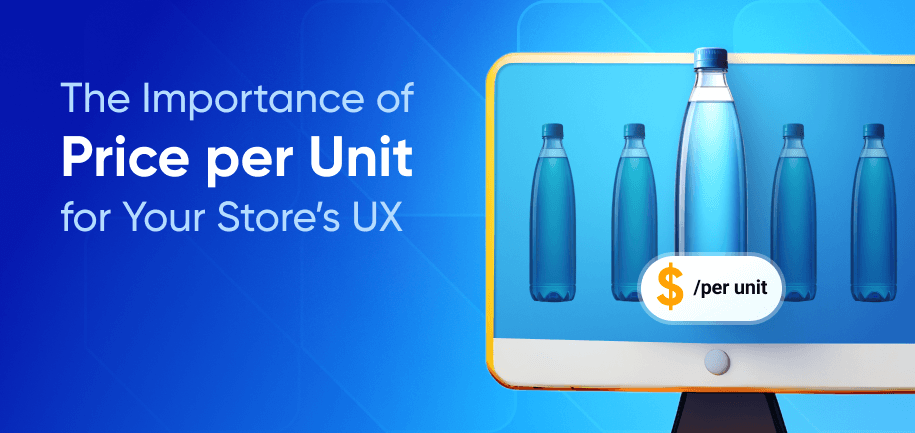Unit pricing – or price per unit – helps shoppers assess value beyond just total price and leads to transparency as well as more informed buying choices. But despite its benefits, unit pricing in e-commerce remains inconsistently implemented.
According to a Baymard Institute recent study, 87% of e-commerce websites fail to provide unit price details, which leads to friction in the decision-making process. This lack of clarity often results in cart abandonment or inefficient promotion campaigns.
In this article, we’ll explore the meaning of unit price, how it’s calculated, and why it matters for both e-commerce businesses and consumers. We’ll also share unit price examples and discuss best practices for integrating price per unit into your store.
What is Unit Price – Definition
Unit price is the cost of a unit of a product per standard unit of measurement (weight or volume), such as per liter, per ounce, or per kilogram. This pricing model allows consumers to compare the cost of different products based on value rather than just total price.
For example, if a 500ml bottle of shampoo costs $10 and a 750ml bottle costs $14, the unit price per 100ml would be:
- 500ml bottle: $10 ÷ 500ml = $2 per 100ml
- 750ml bottle: $14 ÷ 750ml = $1.87 per 100ml
As in this case, the larger bottle offers a better deal than a smaller package based on unit price, even though its total price is higher.
Consumers expect pricing transparency, especially when comparing product variations, bulk deals, or subscription options. Without unit pricing, shoppers may struggle to determine the best value, leading to frustration and lost sales.
Beyond retail, unit pricing also plays a role in manufacturing, where it helps businesses determine the cost per unit based on raw materials, number of units produced, production costs, and materials costs. When calculating unit price in manufacturing, businesses can optimize pricing strategies, reduce waste, and ensure profitability while maintaining competitive pricing.
How to Find Unit Price
Unit price calculation is straightforward, yet businesses often neglect to provide this information in a user-friendly format. The basic formula to find the price per unit is to divide the total price by the total quantity.
Unit Price = Total Price / Total Quantity
For instance, if a 12-pack of bottled water costs $6, and each bottle contains 500ml, the unit price per liter would be:
6 / 12 × 0.5 = 6 / 6 = $1 per liter
When calculating or displaying the calculated unit price, consider the following:
- Consistent Units of Measurement – Standardize how prices are displayed (e.g., per gram, per liter, per item) to avoid confusion.
- Package Variations – Ensure pricing is comparable across different package sizes, bulk offers, and multi-pack discounts.
- Subscription Models & Tiered Pricing – Clearly communicate cost-per-unit for one-time purchases vs. subscriptions.
- Automated Calculations – Implement tools or extensions that dynamically compute and display unit prices on product pages.
Many e-commerce platforms, including Magento 2, lack built-in unit pricing displays. However, third-party solutions, such as Amasty’s Base Price extension, can automate this process, ensuring accurate and regulation-compliant unit pricing.
Why is Per Unit Pricing Important for Your Business
We’ve already briefly covered the positive impact of displaying the price of a single unit in e-commerce, but let’s take a better look at why investing in it is worth the effort.
Trust & Pricing Transparency
Customers appreciate clear pricing that lets them compare products or services objectively and in real time. In testing, when participants had to compare items of different quantities without unit prices, they often struggled to calculate the cost and find the option that saves them money.
Lack of pricing clarity can create doubt, making shoppers question whether they are getting a fair deal, or lead to incorrect assumptions. With unit prices, retailers provide transparent pricing that helps consumers make informed choices with confidence.
Enhanced Conversion Rates
Some products have complex pricing structures, such as weight-based grocery pricing or tiered discounts for bulk purchases. If unit prices aren’t clearly displayed, customers may misinterpret the actual price per unit, leading to frustration or abandoned carts. In fact, Baymard Institute found that pricing complexity is a top contributor to cart abandonment.
Unit pricing simplifies the decision-making process, helping customers quickly identify the best value. It also highlights that smaller packages often have a higher price per unit than bulk purchases, enhancing price perception. Without this insight, shoppers may unknowingly choose a less economical option or opt for a competitor instead.
Support for Data-Driven Pricing Strategies
Your business can leverage unit price insights to optimize its pricing models. Analyzing per-unit costs across different package sizes can help you:
- Identify optimal pricing tiers for bulk or multi-pack sales.
- Adjust subscription pricing to maximize customer retention.
- Ensure consistent profit margins across product variations.
Compliance with Legal Standards
If you’re operating in regulated markets, you must ensure compliance with unit pricing laws. Regions such as the EU, Australia, and parts of the U.S. and Canada require retailers to display unit prices for certain products.
For instance, in the EU, retailers must follow the Price Indication Directive (98/6/EC), while Australia enforces unit pricing through its Competition and Consumer Act 2010. Failure to comply can lead to fines and loss of business.
Higher Competitive Edge
Major platforms like Amazon, Walmart, and Tesco prominently feature price per unit, setting customer expectations. If your business fails to adopt similar pricing transparency, you risk losing sales to competitors with clearer value propositions.
Best Practices for Implementing Unit Pricing in E-commerce Stores
Despite its importance, unit price information is often overlooked in online stores due to technical and design limitations. Many retailers struggle to integrate price per unit effectively, leading to inconsistencies that reduce usability.
Here are the best practices for introducing price per unit in your online store.
1. Choose the Right Pricing Model
Before implementing unit pricing, determine the most relevant pricing unit based on the product type. Common approaches include:
- Weight-based pricing (e.g., per kilogram or per pound for groceries).
- Volume-based pricing (e.g., per liter for beverages and cleaning supplies).
- Quantity-based pricing (e.g., per tablet for pharmaceuticals or per sheet for stationery).
2. Automate Unit Price Calculation
Manually calculating and updating price per unit can be time-consuming, especially for stores with frequently changing prices or bulk discounts. Use a dedicated pricing module, such as Amasty’s Base Price for Magento 2, to benefit from:
- Automatic price per unit calculation based on predefined rules.
- Consistent display of unit pricing across product pages, category pages, and search results.
- Guaranteed compliance with EU and US pricing regulations.
3. Optimize Product Display & UX
To improve customer experience when displaying price per unit, you should:
- Show unit price next to total price to enhance price transparency.
- Highlight per-unit savings for bulk purchases to drive conversions.
- Use comparison tables for products with different package sizes.
4. Ensure Mobile-Friendliness
A significant portion of e-commerce traffic comes from mobile users, yet many sites fail to properly format unit pricing for smaller screens. Best practices include:
- Keeping the unit price text concise to avoid clutter.
- Ensuring it’s visible in product lists and not just product pages.
- Using responsive design to adjust the pricing display dynamically.
Unit Price Examples and Case Studies
For consumers, the ability to compare the unit price is especially important when purchasing in bulk or evaluating different packaging options. Here are some real-world examples of how unit pricing (or the lack of it) impacts shopping decisions:
Wayfair’s Price Per Glass Breakdown
Wayfair simplifies cost comparison by displaying the price per glass when selling sets that may vary in quantity. This makes it easier for shoppers to compare these bulk sets and see the best value: while the set of 6 glasses on the left is costlier, its price per unit is lower than that of the set of 4 goblets on the right.

Sears’ Sock Pricing Complexity
Sears displays total prices for multi-pack socks but does not show the price per pair. This forces customers to calculate the cost themselves, making direct comparisons difficult. In this case found by Baymard Institute, Nike socks were nearly seven times more expensive per pair than a competing brand, but the lack of clear unit pricing required extra effort from shoppers to notice this difference.

Improve Your Store’s Pricing Transparency
Implementing unit pricing is a strategic move that enhances UX, trust, and conversion rates. Retailers who adopt clear price per unit displays can:
- Reduce cart abandonment by simplifying pricing comparisons.
- Increase AOV by highlighting bulk savings and value-driven pricing.
- Stay competitive with industry leaders who already use unit pricing effectively.
If you're looking for an easy way to display price per unit on your Magento store, explore Amasty’s Base Price for Magento 2 for a streamlined implementation.
















